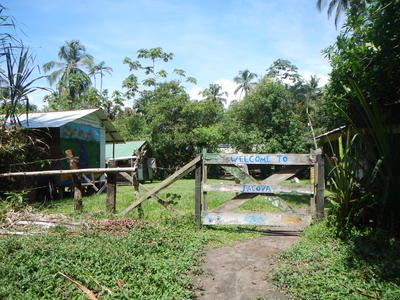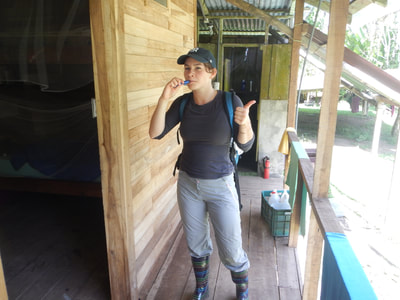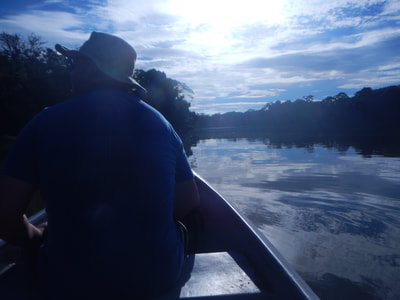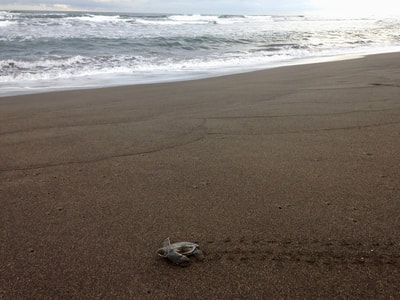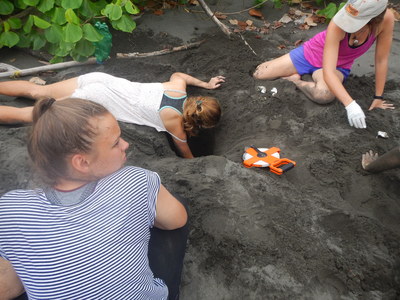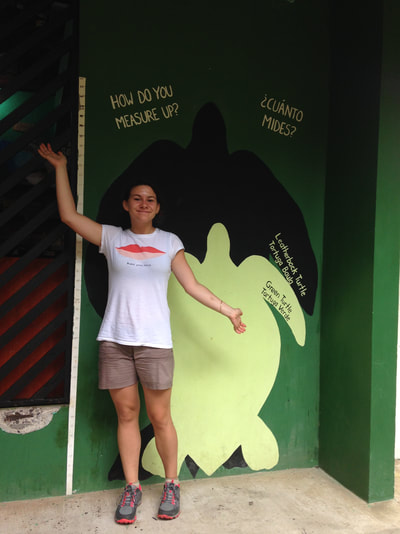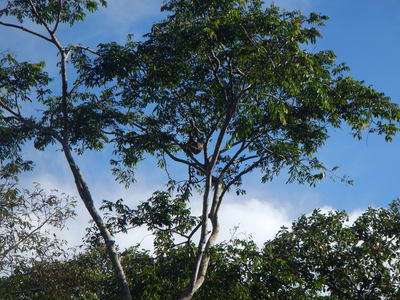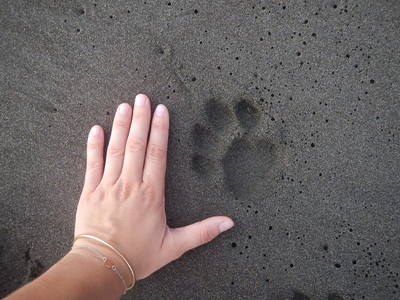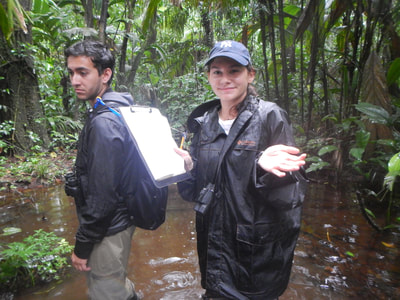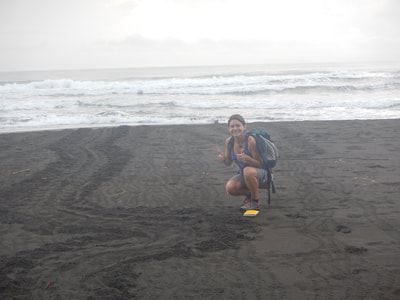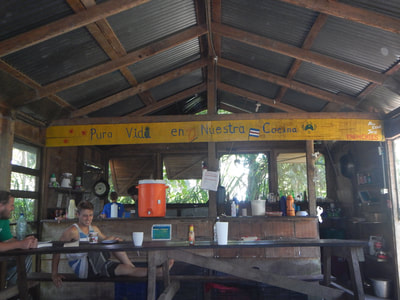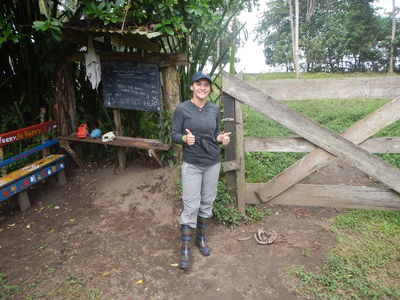My Dream Trip to Costa Rica!
After being chosen by the James Rao Foundation to go live my dream in Costa Rica, the expectation of living an unforgettable experience made the wait for the departure date almost unbearable. Nevertheless, I made it through these few months and I made it through the IB exams which left me with just enough energy to get ready for the big adventure! Because there are a few essentials you should have when going to the jungle which do not include pretty clothes nor heels but rather wellies, binoculars, mosquito repellent, and head-torch. Now I was starting to feel like a true explorer. Armed with my brand new equipment and fully-restored energy, I sat through the 25 hours trip which took me through Amsterdam, Atlanta and finally San José, the Costa Rican capital. There I met with the members of the GVI association and the other volunteer with whom I was going to live for the coming weeks. All were equally tired from their trip but also equally excited to arrive and we happily shared this excitement during the 5hours bus ride; 1hour boat ride and 15min walk through the jungle that led us to our new home.
The Jalova base is situated in the Southern part of the Tortuguero National park, in an area closed to tourists for the protection of its wildlife. Respecting this idea, the base aims to have a very low ecological impact through the limited use of water and electricity (exclusively available 1hour a day for volunteers). The collection of rain water was also used for things like washing clothes, flushing the toilet, and bucket showers for anyone who wished. Moreover, as you can imagine service and internet were not available either. This rudimental settings offered me the opportunity to disconnect from the world and plainly benefit from what natures has to offer: the luxuriant forest, the 13miles long beach, the Atlantic Ocean 200m from base and the singing of the Montezumas (tropical bird) as an alarm clock, the Green Iguanas living here… We were also introduced to the other inhabitants of the base (the human ones) were coming from all over the Western world and very welcoming, for the staff member, they spend most of the year on base and are inspiring by their passion of their job. They collect data on the ecological environment with the help of the volunteers and share it with the Ministry of Environment of Costa Rica along with advice on how to improve protection of the wildlife. In addition, as true scientist they use the data to write ecological papers on subject such as the hunting behaviour of jaguars in the park. After discovering our new home and family, it was time to get to the real business. Our base leader took us through a week of training during which we learnt about the four projects conducted by the staff and about which behaviour to adopt on survey.
The first project, the Bird Project, entailed that we learnt to identify 30 species of local birds so that we could write down when we saw them whilst on survey and on which level of the canopy they were. For this project, we were going by 6 on our loyal canoe proudly named “Porridge” and navigate on the intricate canals of the park. More than birds, we often had the chance to see Capuchin, Howler or Spider monkeys swinging from trees to trees and a few lazy Sloths chilling at the top of the very high almond trees. These surveys definitely reminded me of “Where’s Waldo” when grasping our binoculars, aiming to be the first to spot the less common species or to identify them the fastest. One highlight of the bird survey for me was when I had the chance to go on one
of the few night bird survey. I was looking around through my binoculars, using the light of my head torch to make sense of the dark shapes on the sides of the canals when two bright red lights attracted my attention to what turned out to be a gigantic crocodile laying on the side of the canal! Of course the beast was only slightly annoyed by our lights and only gave us a quick look before going back to his good night of sleep.
The second project, called “Wildlife Project” was focusing on 50 species of vertebrates including frogs, birds, snakes, mammals and anoles which we had to learn along with 15 bird calls. Although learning all this may sound like a pain, it was really fun to do especially by actually seeing the animals on the field during survey. And I learnt loads, fun fact: the Keel-Billed toucan sounds like a frog when he sings! My favourite part of the forest survey was to go deep in the jungle, braving the mud till the knees and the angry spider monkeys throwing branches at us, I really got to feel adventurer and learnt so much about the wonder of the rainforest.
The third project was the Jaguar Project. Tortuguero National Park has a growing population of jaguars which shows unique social and hunting behaviours compared to their cousins in Amazonia. Indeed, it is the first place where we saw jaguars feeding on sea turtles. We investigated this behaviour during our long walks on the beach where we listed where we saw their tracks, where we saw the remaining of their preys and we also set cameras close to it in the hope of catching footages of them. This work was laborious, we sometimes did it under pouring tropical rain or walking up to 15miles in soft sand, but finding a few seconds of videos of our favourite felines was a reward that was worth all of it.
The final project (and my personal favourite) was the Turtle Project. For this one, we went on survey at night on the beach, with the moonshine for only light and with the constant thrill of possibly being observed by jaguars hiding in the vegetation. There, we looked for sea turtles coming on land to nest. When we spotted one, we first looked at what stage she was at: looking for a spot; digging the body-pit; digging the egg-chamber; laying eggs; closing the egg-chamber; or hiding the nest. The overall process can take them up more than an hour and they sometimes give up halfway through to start over a few meters away. We would usually step in whilst the turtle was
digging the egg-chamber so that we could count how many eggs she laid. Doing this was a messy but amazing experience, I counted 80 eggs of a Green Turtles (which I latter named Leonie) that might leave for a hundred years and swim all over the globe!! Seeing the turtles out of their usual habitat, they looked intimidating and seemed to come straight from the jurassic. The experience was truly unforgettable. Moreover, seeing the 10cm long baby turtles crawling out of the sand to join the sea in the early morning two weeks after was like a final show of beauty and emotion. The Live Your Dream Foundation gave me a wonderful opportunity to live my dream and
my trip to Costa Rica can definitely be qualified as such.
Through this experience I discovered an environment I would otherwise never have encountered and helped me to grown as a person whilst participating in the protection of the environment. My advice to all students of the IST is to not let this occasion pass you by! Be bold, and apply to go on the trip you barely dare thinking about! I promise you will not regret it, I know I don’t.
The Jalova base is situated in the Southern part of the Tortuguero National park, in an area closed to tourists for the protection of its wildlife. Respecting this idea, the base aims to have a very low ecological impact through the limited use of water and electricity (exclusively available 1hour a day for volunteers). The collection of rain water was also used for things like washing clothes, flushing the toilet, and bucket showers for anyone who wished. Moreover, as you can imagine service and internet were not available either. This rudimental settings offered me the opportunity to disconnect from the world and plainly benefit from what natures has to offer: the luxuriant forest, the 13miles long beach, the Atlantic Ocean 200m from base and the singing of the Montezumas (tropical bird) as an alarm clock, the Green Iguanas living here… We were also introduced to the other inhabitants of the base (the human ones) were coming from all over the Western world and very welcoming, for the staff member, they spend most of the year on base and are inspiring by their passion of their job. They collect data on the ecological environment with the help of the volunteers and share it with the Ministry of Environment of Costa Rica along with advice on how to improve protection of the wildlife. In addition, as true scientist they use the data to write ecological papers on subject such as the hunting behaviour of jaguars in the park. After discovering our new home and family, it was time to get to the real business. Our base leader took us through a week of training during which we learnt about the four projects conducted by the staff and about which behaviour to adopt on survey.
The first project, the Bird Project, entailed that we learnt to identify 30 species of local birds so that we could write down when we saw them whilst on survey and on which level of the canopy they were. For this project, we were going by 6 on our loyal canoe proudly named “Porridge” and navigate on the intricate canals of the park. More than birds, we often had the chance to see Capuchin, Howler or Spider monkeys swinging from trees to trees and a few lazy Sloths chilling at the top of the very high almond trees. These surveys definitely reminded me of “Where’s Waldo” when grasping our binoculars, aiming to be the first to spot the less common species or to identify them the fastest. One highlight of the bird survey for me was when I had the chance to go on one
of the few night bird survey. I was looking around through my binoculars, using the light of my head torch to make sense of the dark shapes on the sides of the canals when two bright red lights attracted my attention to what turned out to be a gigantic crocodile laying on the side of the canal! Of course the beast was only slightly annoyed by our lights and only gave us a quick look before going back to his good night of sleep.
The second project, called “Wildlife Project” was focusing on 50 species of vertebrates including frogs, birds, snakes, mammals and anoles which we had to learn along with 15 bird calls. Although learning all this may sound like a pain, it was really fun to do especially by actually seeing the animals on the field during survey. And I learnt loads, fun fact: the Keel-Billed toucan sounds like a frog when he sings! My favourite part of the forest survey was to go deep in the jungle, braving the mud till the knees and the angry spider monkeys throwing branches at us, I really got to feel adventurer and learnt so much about the wonder of the rainforest.
The third project was the Jaguar Project. Tortuguero National Park has a growing population of jaguars which shows unique social and hunting behaviours compared to their cousins in Amazonia. Indeed, it is the first place where we saw jaguars feeding on sea turtles. We investigated this behaviour during our long walks on the beach where we listed where we saw their tracks, where we saw the remaining of their preys and we also set cameras close to it in the hope of catching footages of them. This work was laborious, we sometimes did it under pouring tropical rain or walking up to 15miles in soft sand, but finding a few seconds of videos of our favourite felines was a reward that was worth all of it.
The final project (and my personal favourite) was the Turtle Project. For this one, we went on survey at night on the beach, with the moonshine for only light and with the constant thrill of possibly being observed by jaguars hiding in the vegetation. There, we looked for sea turtles coming on land to nest. When we spotted one, we first looked at what stage she was at: looking for a spot; digging the body-pit; digging the egg-chamber; laying eggs; closing the egg-chamber; or hiding the nest. The overall process can take them up more than an hour and they sometimes give up halfway through to start over a few meters away. We would usually step in whilst the turtle was
digging the egg-chamber so that we could count how many eggs she laid. Doing this was a messy but amazing experience, I counted 80 eggs of a Green Turtles (which I latter named Leonie) that might leave for a hundred years and swim all over the globe!! Seeing the turtles out of their usual habitat, they looked intimidating and seemed to come straight from the jurassic. The experience was truly unforgettable. Moreover, seeing the 10cm long baby turtles crawling out of the sand to join the sea in the early morning two weeks after was like a final show of beauty and emotion. The Live Your Dream Foundation gave me a wonderful opportunity to live my dream and
my trip to Costa Rica can definitely be qualified as such.
Through this experience I discovered an environment I would otherwise never have encountered and helped me to grown as a person whilst participating in the protection of the environment. My advice to all students of the IST is to not let this occasion pass you by! Be bold, and apply to go on the trip you barely dare thinking about! I promise you will not regret it, I know I don’t.
Before the adventure...
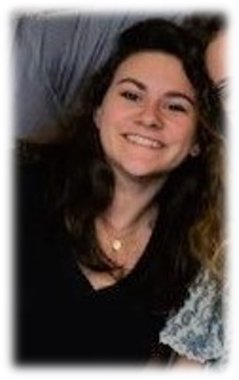
My name is Alice and right after graduating I’ll be flying off to Costa Rica with Global Vision International!
My adventure will take place in a base in the Tortuguero National Park where I will be doing some wildlife conservation for a month. The program is engaged in a number of key areas, including the study of jaguar predation of sea turtles and assessment of any possible impact on turtle populations, jaguar tracking and prey monitoring, migratory/resident bird species long-term trend data, biological assessment surveys in specific habitat areas, and turtle nesting studies and conservation. I am particularly excited about this last point as it will be nesting season and this coast is home to one of the largest nesting colonies of Green Turtles in the world.
Hence, my first flight will be on the 23rd of June and after stopping in Paris and Atlanta I will land in San José Airport the next day. However, there is no road access to the base and I will need to take a boat or canoe through the canals to get there.
I am looking forward to being surrounded by tropical rainforest and Caribbean beaches, enjoying the unique scenery away from civilization and my usual lifestyle. Though I won’t be by myself of course! The program is led by professional scientist whom will teach the group how to be respectful of the environment and how to get on with our conservation efforts.
In addition, I chose this program because it will have an actual impact on the environment as all the results of the survey are sent and analyzed by the Costa Rican government to help them make important conservation decisions and ensure the survival of the biodiversity of this unique area of the rainforest.
Overall, I know this month will be a unique experience from which I’ll benefit all throughout my life thanks to the Live Your Dream Foundation.
My adventure will take place in a base in the Tortuguero National Park where I will be doing some wildlife conservation for a month. The program is engaged in a number of key areas, including the study of jaguar predation of sea turtles and assessment of any possible impact on turtle populations, jaguar tracking and prey monitoring, migratory/resident bird species long-term trend data, biological assessment surveys in specific habitat areas, and turtle nesting studies and conservation. I am particularly excited about this last point as it will be nesting season and this coast is home to one of the largest nesting colonies of Green Turtles in the world.
Hence, my first flight will be on the 23rd of June and after stopping in Paris and Atlanta I will land in San José Airport the next day. However, there is no road access to the base and I will need to take a boat or canoe through the canals to get there.
I am looking forward to being surrounded by tropical rainforest and Caribbean beaches, enjoying the unique scenery away from civilization and my usual lifestyle. Though I won’t be by myself of course! The program is led by professional scientist whom will teach the group how to be respectful of the environment and how to get on with our conservation efforts.
In addition, I chose this program because it will have an actual impact on the environment as all the results of the survey are sent and analyzed by the Costa Rican government to help them make important conservation decisions and ensure the survival of the biodiversity of this unique area of the rainforest.
Overall, I know this month will be a unique experience from which I’ll benefit all throughout my life thanks to the Live Your Dream Foundation.
